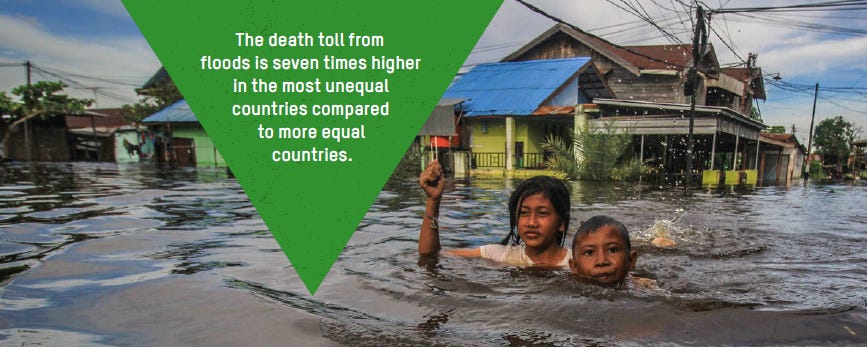Part 2: An unequal disaster
In the second part of our climate inequality series, we’re lifting the lid on the unequal impacts of climate change.
Last week we covered the latest data on the inequality of carbon emissions. This week we're looking at how the impacts of climate change are being redistributed onto the poorest and most marginalized, while the richest insulate themselves.
Remember to subscribe to Equals and recommend us to your friends. In our next newsletter, we’ll look at the ability and responsibility of countries and people to respond to climate breakdown.
Unequal impact in numbers
The stark reality. One of the most visceral examples of inequality of impact is the experience of a hot day in rich and poorer neighbourhoods in the same city. A study of housing in Ahmedabad, India, found an average temperature difference of 7.6°C between formal and informal housing. Tin shacks in Mumbai are 6°C warmer than their richer neighbours.
Attributing deaths caused by carbon pollution. Based on the analysis of the emissions of the top 1% in 2019, we found that it was enough to cause 1.3 million excess deaths due to heat, with most of those deaths between 2020 and 2030. These deaths are concentrated in poorer countries with heat stress deaths expected to increase in low-income countries and fall in high-income countries.
The link between inequality and death tolls. Examining flood disasters, Oxfam’s analysis found that unequal countries suffer seven times more flood fatalities than more equal countries
The countries least responsible are being hit the hardest. More than 91% of deaths caused by climate-related disasters in the last 50 years occurred in low- and middle-income countries. In Ethiopia, Kenya, Somalia and South Sudan, severe drought and flooding have left a record 40 million people facing extreme hunger, more than the population of Canada.
Inequality of agricultural damage. The unequal impacts on agricultural productivity between countries is extreme —agricultural productivity in Africa is estimated to be almost 35% below its potential value because of climate change while many of the richest, highest-emitting countries are relatively protected (see figure below).
When economic inequality intersects with inequalities of power. Women, ethnic minorities and other groups experiencing discrimination —particularly those with fewer economic resources— tend to have less access to relief assistance and lower survival rates following a climate-related disaster. In Nepal in 2011, for example, only 6% of the poorest people sought government support following extreme weather events, compared to 90% of the well-off.
The climate inequality trap. As people living in poverty get hit hardest by the effects of the climate crisis, their ability to respond and build resilience is further weakened —widening the yawning gap between them and the richest. Inequality between rich and poorer countries is 25% higher because of climate change.
No such thing as a “natural” disaster. Whether an extreme weather event becomes a disaster depends on the levels of existing inequality in a country and the way society is organized. Without reducing global and national levels of inequality, the climate and inequality trap will grow.
Something to read/watch
Some hope. Luckily the elite at COP28 are finally taking things seriously and discussing the things that matter, like “responsible yachting”. Last week’s readers might wonder how Lauren Sánchez, Jeff Bezos’ fiancé, would feel though —that boat doesn’t even have a sail!
A public service announcement from Oblivia Coalmine, the latex-clad oil exec thanking us for propping up the industry with our pensions.






